Tourism Marketing
VerifiedAdded on 2023/04/20
|19
|4132
|319
AI Summary
This document provides an analysis of the market potential, transport development, accommodation development, crisis and risk management services, social media influences, and visitor experience development considerations in tourism marketing. The focus is on Iceland as a destination, discussing its steady growth in the tourism industry and the factors that make it an ideal international destination. The document also explores the potential of the tourism market in Iceland, the transport options available, the development of accommodation services, and the crisis and risk management considerations that need to be made. Overall, it provides valuable insights for successfully promoting and capturing the Icelandic tourism market.
Contribute Materials
Your contribution can guide someone’s learning journey. Share your
documents today.
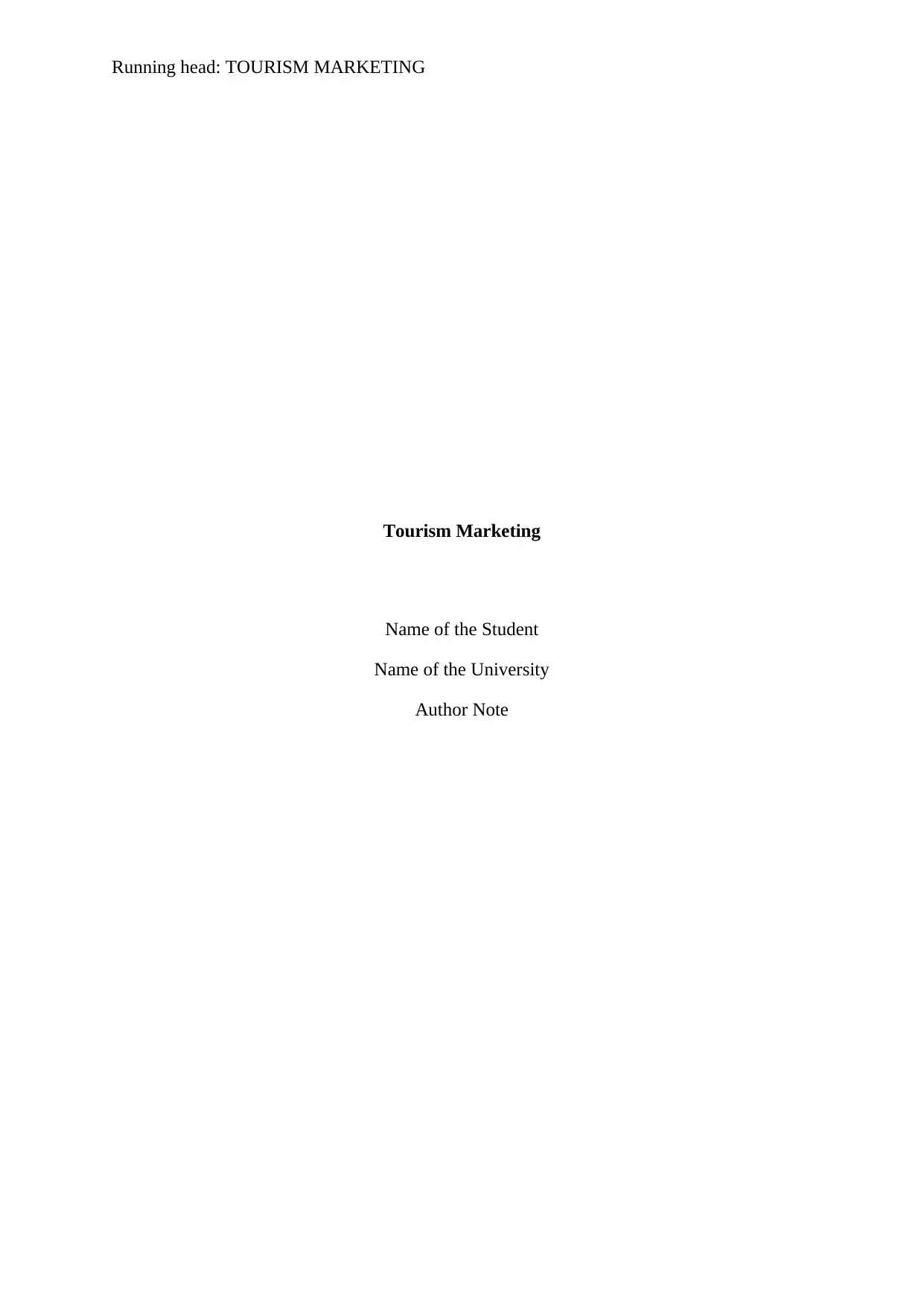
Running head: TOURISM MARKETING
Tourism Marketing
Name of the Student
Name of the University
Author Note
Tourism Marketing
Name of the Student
Name of the University
Author Note
Secure Best Marks with AI Grader
Need help grading? Try our AI Grader for instant feedback on your assignments.
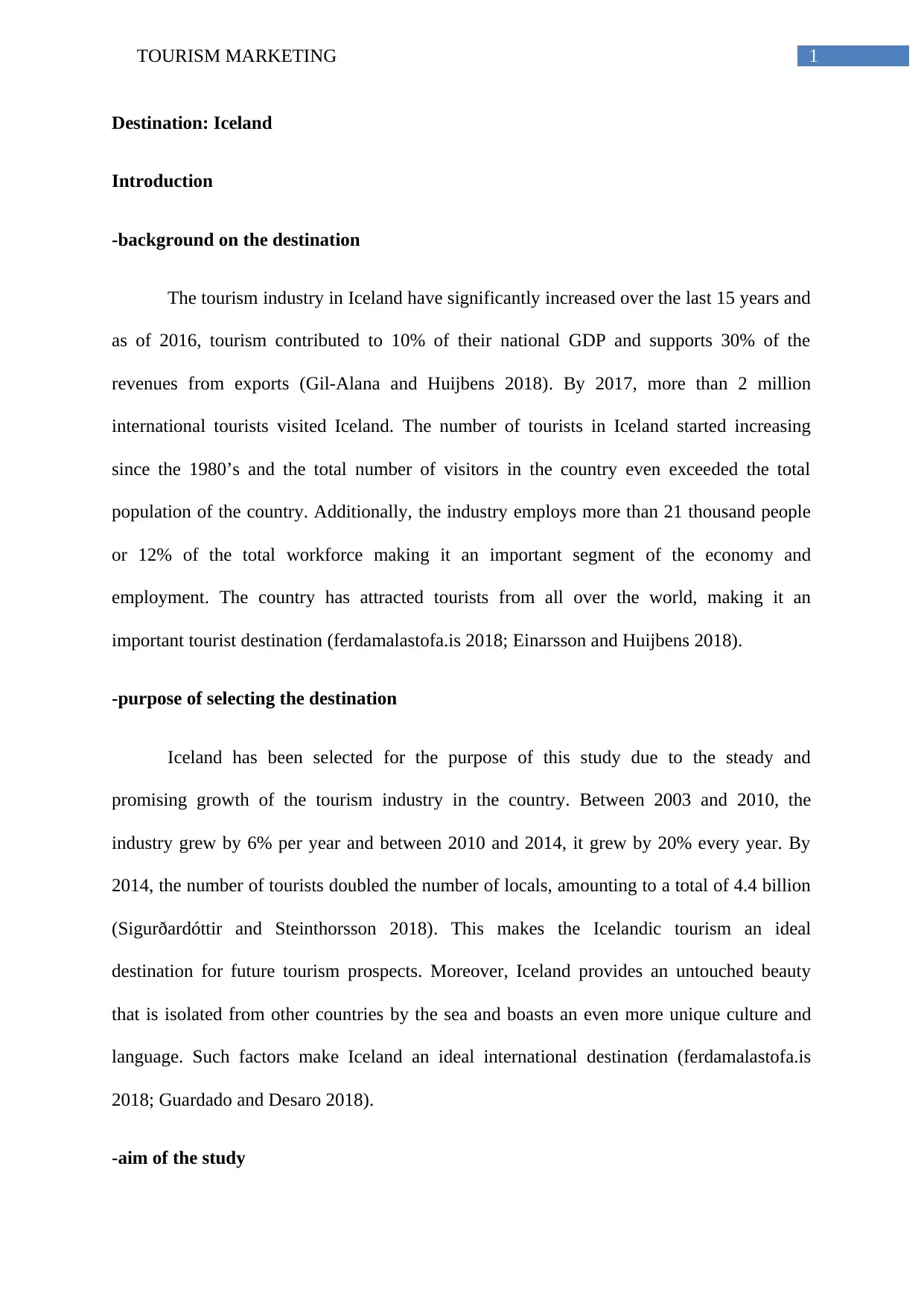
1TOURISM MARKETING
Destination: Iceland
Introduction
-background on the destination
The tourism industry in Iceland have significantly increased over the last 15 years and
as of 2016, tourism contributed to 10% of their national GDP and supports 30% of the
revenues from exports (Gil-Alana and Huijbens 2018). By 2017, more than 2 million
international tourists visited Iceland. The number of tourists in Iceland started increasing
since the 1980’s and the total number of visitors in the country even exceeded the total
population of the country. Additionally, the industry employs more than 21 thousand people
or 12% of the total workforce making it an important segment of the economy and
employment. The country has attracted tourists from all over the world, making it an
important tourist destination (ferdamalastofa.is 2018; Einarsson and Huijbens 2018).
-purpose of selecting the destination
Iceland has been selected for the purpose of this study due to the steady and
promising growth of the tourism industry in the country. Between 2003 and 2010, the
industry grew by 6% per year and between 2010 and 2014, it grew by 20% every year. By
2014, the number of tourists doubled the number of locals, amounting to a total of 4.4 billion
(Sigurðardóttir and Steinthorsson 2018). This makes the Icelandic tourism an ideal
destination for future tourism prospects. Moreover, Iceland provides an untouched beauty
that is isolated from other countries by the sea and boasts an even more unique culture and
language. Such factors make Iceland an ideal international destination (ferdamalastofa.is
2018; Guardado and Desaro 2018).
-aim of the study
Destination: Iceland
Introduction
-background on the destination
The tourism industry in Iceland have significantly increased over the last 15 years and
as of 2016, tourism contributed to 10% of their national GDP and supports 30% of the
revenues from exports (Gil-Alana and Huijbens 2018). By 2017, more than 2 million
international tourists visited Iceland. The number of tourists in Iceland started increasing
since the 1980’s and the total number of visitors in the country even exceeded the total
population of the country. Additionally, the industry employs more than 21 thousand people
or 12% of the total workforce making it an important segment of the economy and
employment. The country has attracted tourists from all over the world, making it an
important tourist destination (ferdamalastofa.is 2018; Einarsson and Huijbens 2018).
-purpose of selecting the destination
Iceland has been selected for the purpose of this study due to the steady and
promising growth of the tourism industry in the country. Between 2003 and 2010, the
industry grew by 6% per year and between 2010 and 2014, it grew by 20% every year. By
2014, the number of tourists doubled the number of locals, amounting to a total of 4.4 billion
(Sigurðardóttir and Steinthorsson 2018). This makes the Icelandic tourism an ideal
destination for future tourism prospects. Moreover, Iceland provides an untouched beauty
that is isolated from other countries by the sea and boasts an even more unique culture and
language. Such factors make Iceland an ideal international destination (ferdamalastofa.is
2018; Guardado and Desaro 2018).
-aim of the study
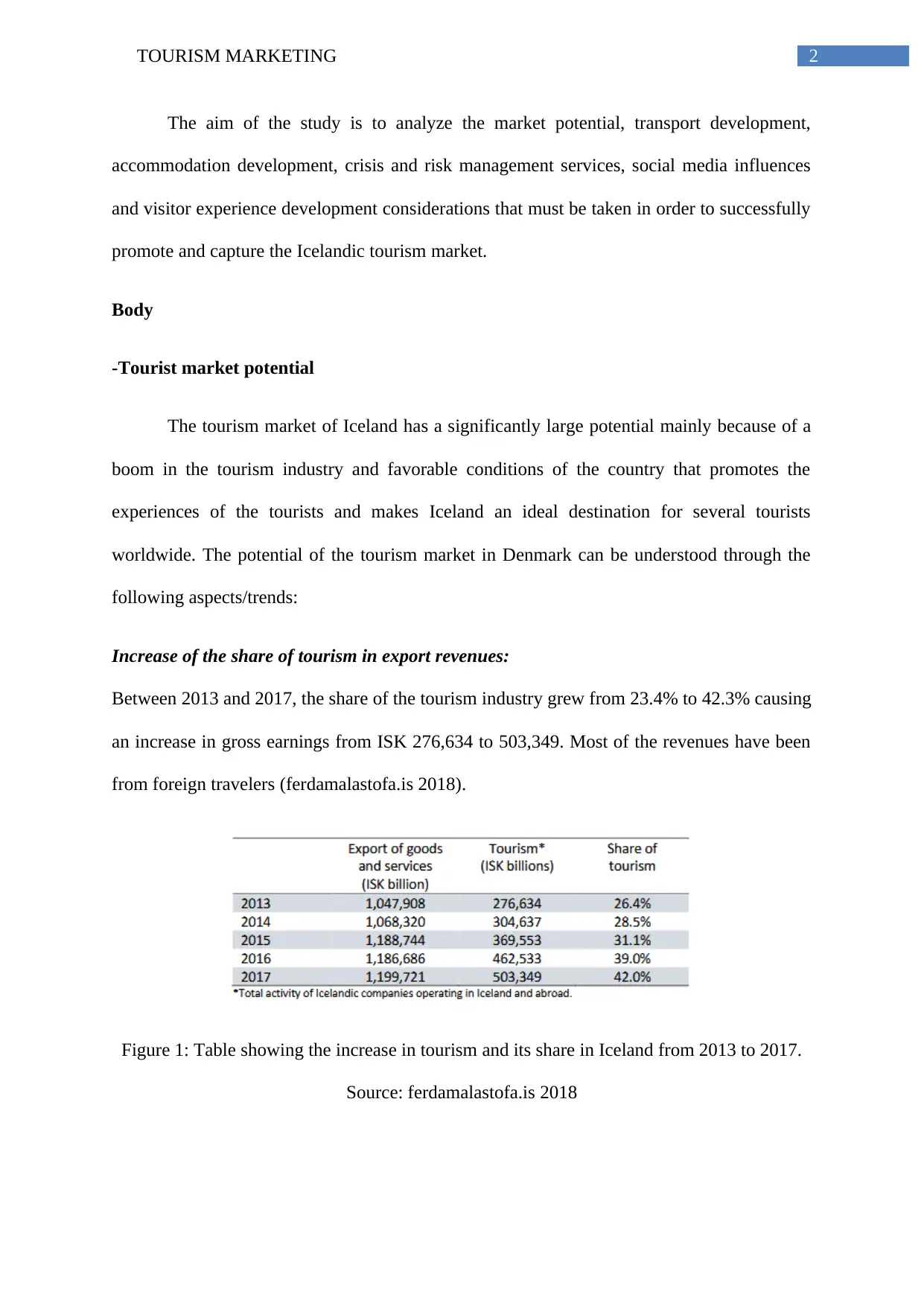
2TOURISM MARKETING
The aim of the study is to analyze the market potential, transport development,
accommodation development, crisis and risk management services, social media influences
and visitor experience development considerations that must be taken in order to successfully
promote and capture the Icelandic tourism market.
Body
-Tourist market potential
The tourism market of Iceland has a significantly large potential mainly because of a
boom in the tourism industry and favorable conditions of the country that promotes the
experiences of the tourists and makes Iceland an ideal destination for several tourists
worldwide. The potential of the tourism market in Denmark can be understood through the
following aspects/trends:
Increase of the share of tourism in export revenues:
Between 2013 and 2017, the share of the tourism industry grew from 23.4% to 42.3% causing
an increase in gross earnings from ISK 276,634 to 503,349. Most of the revenues have been
from foreign travelers (ferdamalastofa.is 2018).
Figure 1: Table showing the increase in tourism and its share in Iceland from 2013 to 2017.
Source: ferdamalastofa.is 2018
The aim of the study is to analyze the market potential, transport development,
accommodation development, crisis and risk management services, social media influences
and visitor experience development considerations that must be taken in order to successfully
promote and capture the Icelandic tourism market.
Body
-Tourist market potential
The tourism market of Iceland has a significantly large potential mainly because of a
boom in the tourism industry and favorable conditions of the country that promotes the
experiences of the tourists and makes Iceland an ideal destination for several tourists
worldwide. The potential of the tourism market in Denmark can be understood through the
following aspects/trends:
Increase of the share of tourism in export revenues:
Between 2013 and 2017, the share of the tourism industry grew from 23.4% to 42.3% causing
an increase in gross earnings from ISK 276,634 to 503,349. Most of the revenues have been
from foreign travelers (ferdamalastofa.is 2018).
Figure 1: Table showing the increase in tourism and its share in Iceland from 2013 to 2017.
Source: ferdamalastofa.is 2018
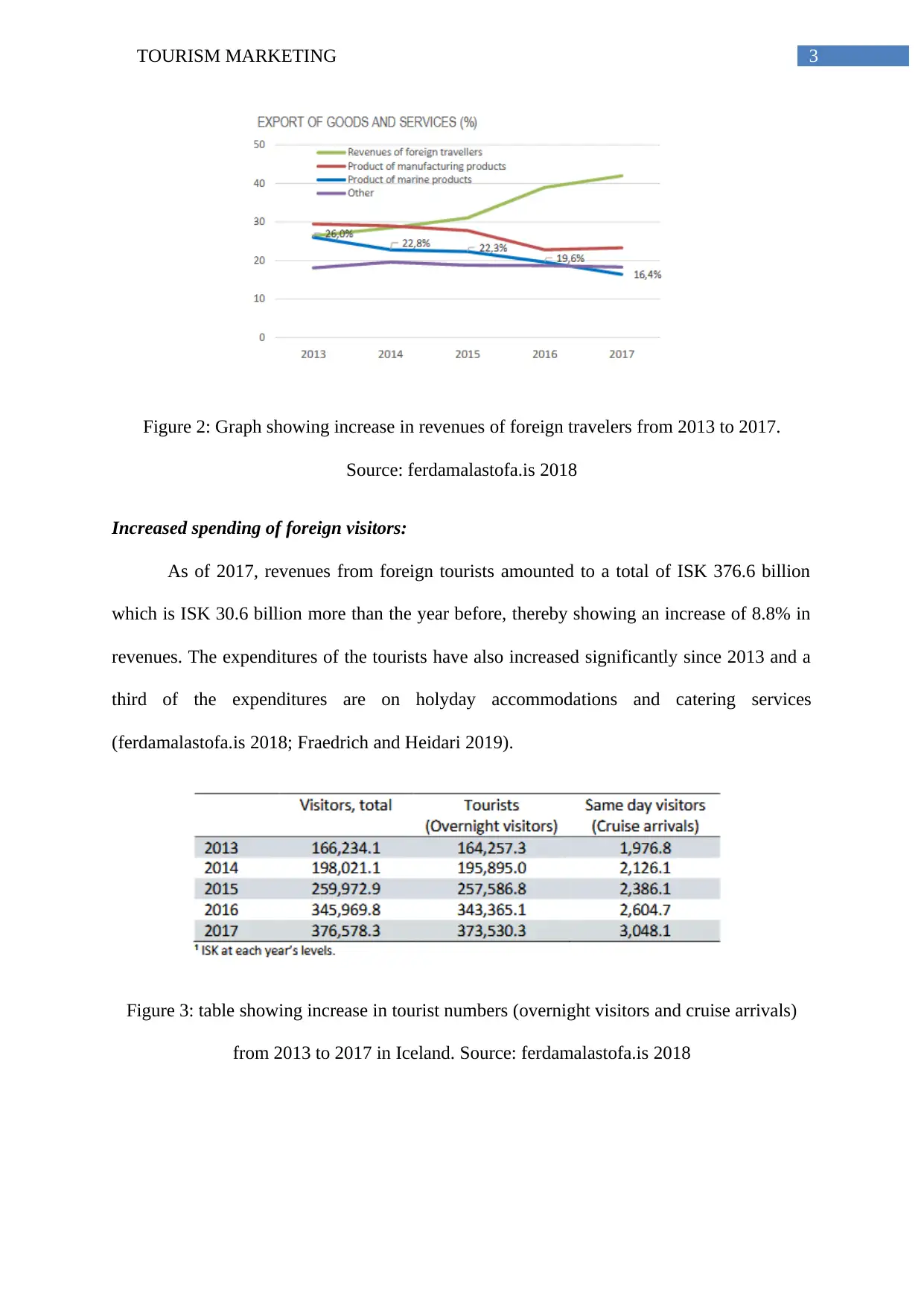
3TOURISM MARKETING
Figure 2: Graph showing increase in revenues of foreign travelers from 2013 to 2017.
Source: ferdamalastofa.is 2018
Increased spending of foreign visitors:
As of 2017, revenues from foreign tourists amounted to a total of ISK 376.6 billion
which is ISK 30.6 billion more than the year before, thereby showing an increase of 8.8% in
revenues. The expenditures of the tourists have also increased significantly since 2013 and a
third of the expenditures are on holyday accommodations and catering services
(ferdamalastofa.is 2018; Fraedrich and Heidari 2019).
Figure 3: table showing increase in tourist numbers (overnight visitors and cruise arrivals)
from 2013 to 2017 in Iceland. Source: ferdamalastofa.is 2018
Figure 2: Graph showing increase in revenues of foreign travelers from 2013 to 2017.
Source: ferdamalastofa.is 2018
Increased spending of foreign visitors:
As of 2017, revenues from foreign tourists amounted to a total of ISK 376.6 billion
which is ISK 30.6 billion more than the year before, thereby showing an increase of 8.8% in
revenues. The expenditures of the tourists have also increased significantly since 2013 and a
third of the expenditures are on holyday accommodations and catering services
(ferdamalastofa.is 2018; Fraedrich and Heidari 2019).
Figure 3: table showing increase in tourist numbers (overnight visitors and cruise arrivals)
from 2013 to 2017 in Iceland. Source: ferdamalastofa.is 2018
Paraphrase This Document
Need a fresh take? Get an instant paraphrase of this document with our AI Paraphraser

4TOURISM MARKETING
Figure 4: Inbound tourism expenditures in Iceland by consumption production 2017. Source:
ferdamalastofa.is 2018
Increase of jobs in tourism related industries
Number of people employed by the tourism industry in Iceland has increased
significantly since 2013. Most of the improvement in employment has been in the sectors of
accommodations, food and beverage services, passenger air transportation, travel agencies,
tour operations and reservation services (Stefánsson et al. 2017; ferdamalastofa.is 2018).
Figure 4: Inbound tourism expenditures in Iceland by consumption production 2017. Source:
ferdamalastofa.is 2018
Increase of jobs in tourism related industries
Number of people employed by the tourism industry in Iceland has increased
significantly since 2013. Most of the improvement in employment has been in the sectors of
accommodations, food and beverage services, passenger air transportation, travel agencies,
tour operations and reservation services (Stefánsson et al. 2017; ferdamalastofa.is 2018).
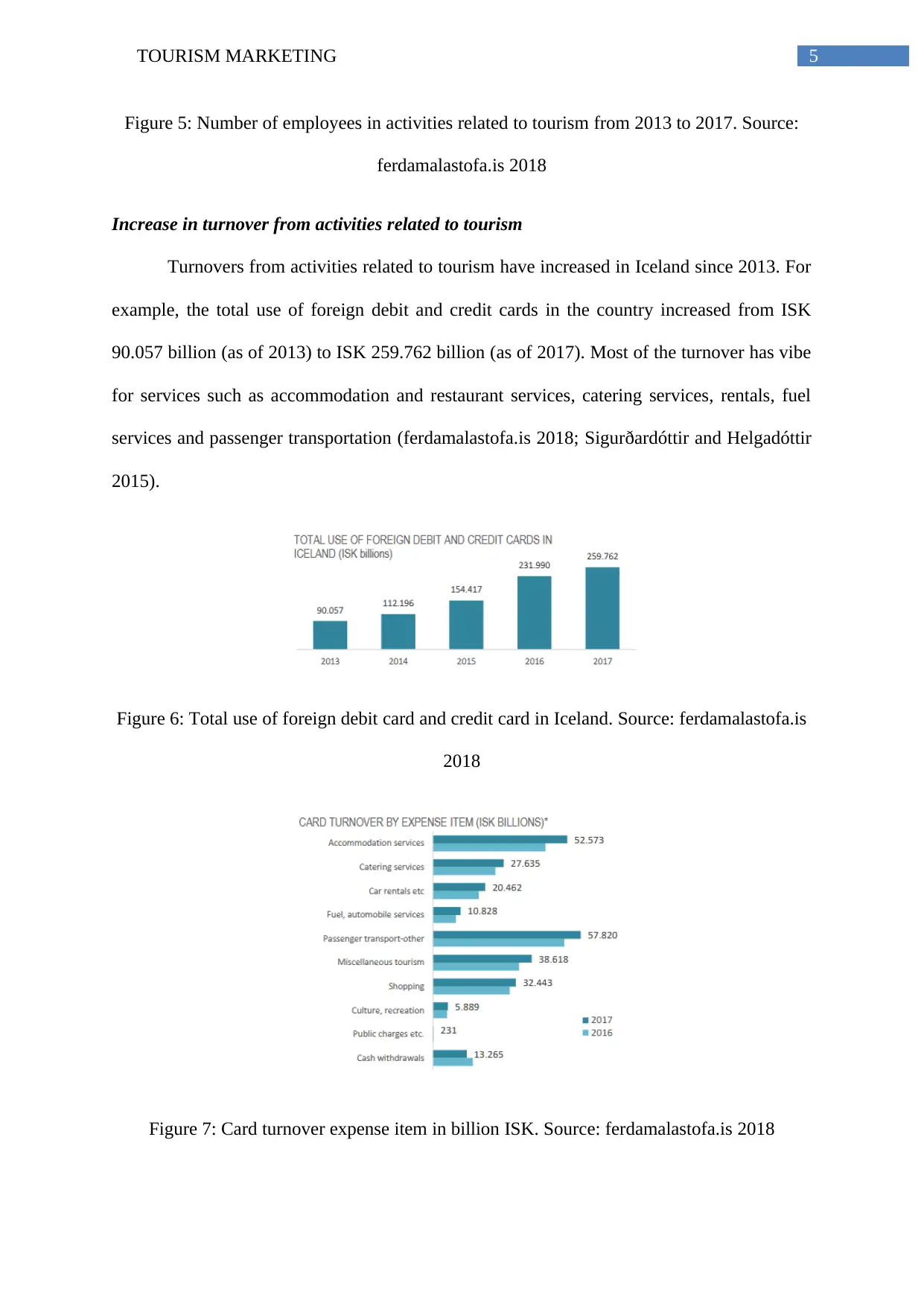
5TOURISM MARKETING
Figure 5: Number of employees in activities related to tourism from 2013 to 2017. Source:
ferdamalastofa.is 2018
Increase in turnover from activities related to tourism
Turnovers from activities related to tourism have increased in Iceland since 2013. For
example, the total use of foreign debit and credit cards in the country increased from ISK
90.057 billion (as of 2013) to ISK 259.762 billion (as of 2017). Most of the turnover has vibe
for services such as accommodation and restaurant services, catering services, rentals, fuel
services and passenger transportation (ferdamalastofa.is 2018; Sigurðardóttir and Helgadóttir
2015).
Figure 6: Total use of foreign debit card and credit card in Iceland. Source: ferdamalastofa.is
2018
Figure 7: Card turnover expense item in billion ISK. Source: ferdamalastofa.is 2018
Figure 5: Number of employees in activities related to tourism from 2013 to 2017. Source:
ferdamalastofa.is 2018
Increase in turnover from activities related to tourism
Turnovers from activities related to tourism have increased in Iceland since 2013. For
example, the total use of foreign debit and credit cards in the country increased from ISK
90.057 billion (as of 2013) to ISK 259.762 billion (as of 2017). Most of the turnover has vibe
for services such as accommodation and restaurant services, catering services, rentals, fuel
services and passenger transportation (ferdamalastofa.is 2018; Sigurðardóttir and Helgadóttir
2015).
Figure 6: Total use of foreign debit card and credit card in Iceland. Source: ferdamalastofa.is
2018
Figure 7: Card turnover expense item in billion ISK. Source: ferdamalastofa.is 2018

6TOURISM MARKETING
Increased number of international visitors
One of the most important aspects that clearly show a growth in the tourism market in
Iceland is a steady increase of international tourists to the country since 2010 from 488,600 to
2,224,600 as of 2017 with a 24.3 % increase since 2010. The increase have been considered
exponential by many authors, showing the boom in its growth (Chen 2015; Sigurðardóttir and
Steinthorsson 2018; ferdamalastofa.is 2018).
Figure 8: Table showing increase in the number of visitors and a proportional increase in the
percentage of foreign visitors in Iceland compared to the nation’s total population. Source:
ferdamalastofa.is 2018
Figure 9: Increase in international visitors from 2010 to 2017. Source: ferdamalastofa.is 2018
Increased number of international visitors
One of the most important aspects that clearly show a growth in the tourism market in
Iceland is a steady increase of international tourists to the country since 2010 from 488,600 to
2,224,600 as of 2017 with a 24.3 % increase since 2010. The increase have been considered
exponential by many authors, showing the boom in its growth (Chen 2015; Sigurðardóttir and
Steinthorsson 2018; ferdamalastofa.is 2018).
Figure 8: Table showing increase in the number of visitors and a proportional increase in the
percentage of foreign visitors in Iceland compared to the nation’s total population. Source:
ferdamalastofa.is 2018
Figure 9: Increase in international visitors from 2010 to 2017. Source: ferdamalastofa.is 2018
Secure Best Marks with AI Grader
Need help grading? Try our AI Grader for instant feedback on your assignments.
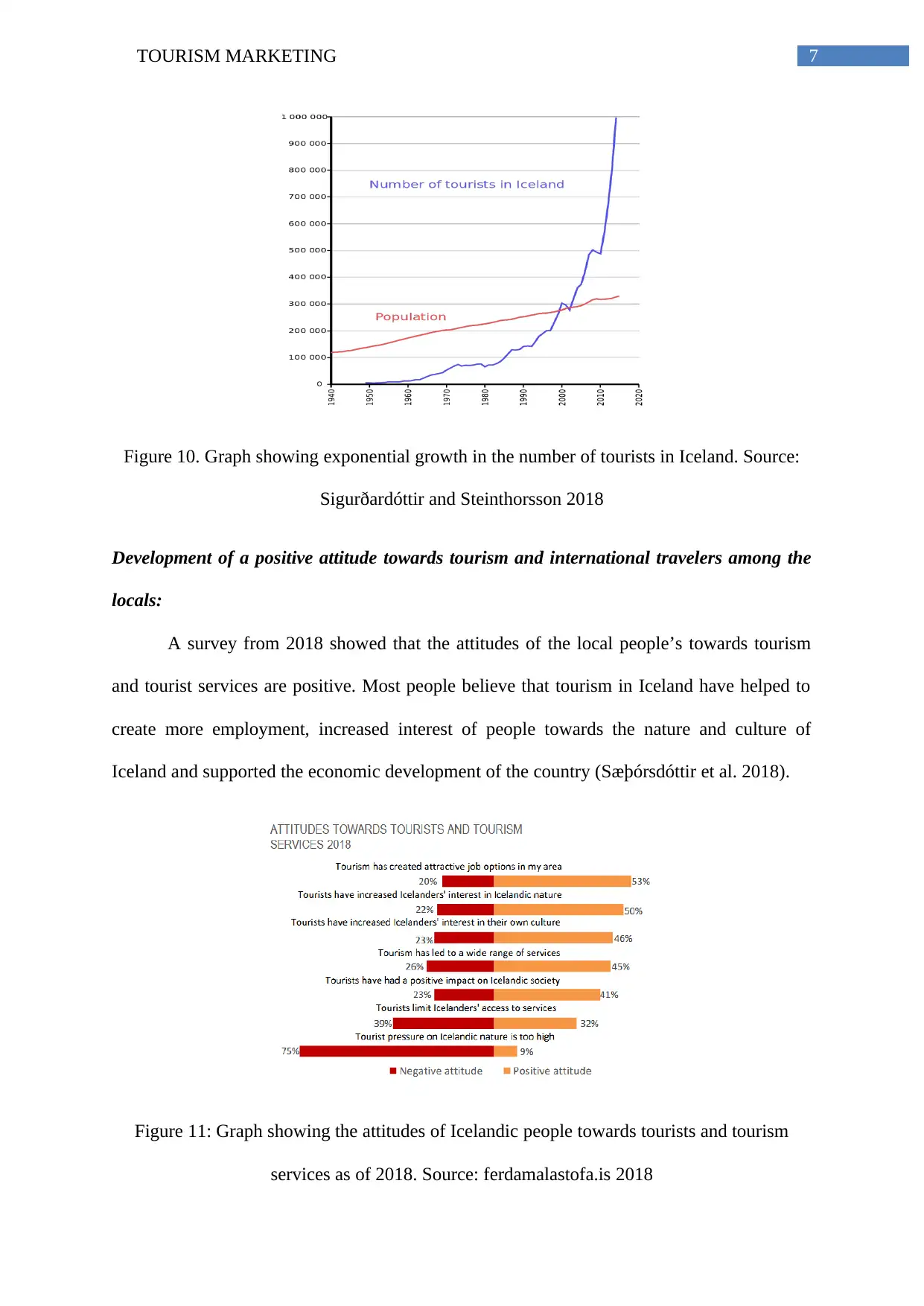
7TOURISM MARKETING
Figure 10. Graph showing exponential growth in the number of tourists in Iceland. Source:
Sigurðardóttir and Steinthorsson 2018
Development of a positive attitude towards tourism and international travelers among the
locals:
A survey from 2018 showed that the attitudes of the local people’s towards tourism
and tourist services are positive. Most people believe that tourism in Iceland have helped to
create more employment, increased interest of people towards the nature and culture of
Iceland and supported the economic development of the country (Sæþórsdóttir et al. 2018).
Figure 11: Graph showing the attitudes of Icelandic people towards tourists and tourism
services as of 2018. Source: ferdamalastofa.is 2018
Figure 10. Graph showing exponential growth in the number of tourists in Iceland. Source:
Sigurðardóttir and Steinthorsson 2018
Development of a positive attitude towards tourism and international travelers among the
locals:
A survey from 2018 showed that the attitudes of the local people’s towards tourism
and tourist services are positive. Most people believe that tourism in Iceland have helped to
create more employment, increased interest of people towards the nature and culture of
Iceland and supported the economic development of the country (Sæþórsdóttir et al. 2018).
Figure 11: Graph showing the attitudes of Icelandic people towards tourists and tourism
services as of 2018. Source: ferdamalastofa.is 2018
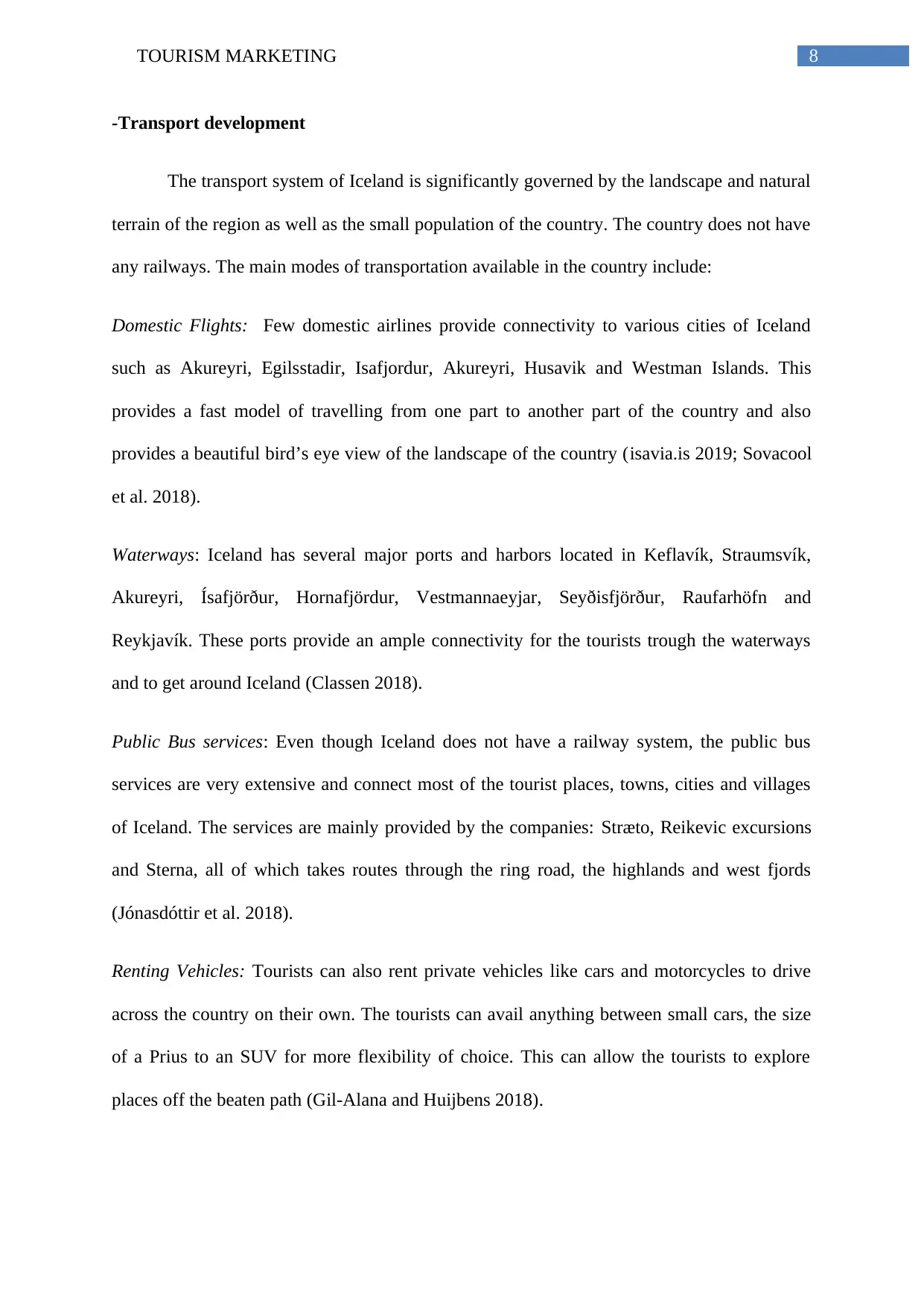
8TOURISM MARKETING
-Transport development
The transport system of Iceland is significantly governed by the landscape and natural
terrain of the region as well as the small population of the country. The country does not have
any railways. The main modes of transportation available in the country include:
Domestic Flights: Few domestic airlines provide connectivity to various cities of Iceland
such as Akureyri, Egilsstadir, Isafjordur, Akureyri, Husavik and Westman Islands. This
provides a fast model of travelling from one part to another part of the country and also
provides a beautiful bird’s eye view of the landscape of the country (isavia.is 2019; Sovacool
et al. 2018).
Waterways: Iceland has several major ports and harbors located in Keflavík, Straumsvík,
Akureyri, Ísafjörður, Hornafjördur, Vestmannaeyjar, Seyðisfjörður, Raufarhöfn and
Reykjavík. These ports provide an ample connectivity for the tourists trough the waterways
and to get around Iceland (Classen 2018).
Public Bus services: Even though Iceland does not have a railway system, the public bus
services are very extensive and connect most of the tourist places, towns, cities and villages
of Iceland. The services are mainly provided by the companies: Stræto, Reikevic excursions
and Sterna, all of which takes routes through the ring road, the highlands and west fjords
(Jónasdóttir et al. 2018).
Renting Vehicles: Tourists can also rent private vehicles like cars and motorcycles to drive
across the country on their own. The tourists can avail anything between small cars, the size
of a Prius to an SUV for more flexibility of choice. This can allow the tourists to explore
places off the beaten path (Gil-Alana and Huijbens 2018).
-Transport development
The transport system of Iceland is significantly governed by the landscape and natural
terrain of the region as well as the small population of the country. The country does not have
any railways. The main modes of transportation available in the country include:
Domestic Flights: Few domestic airlines provide connectivity to various cities of Iceland
such as Akureyri, Egilsstadir, Isafjordur, Akureyri, Husavik and Westman Islands. This
provides a fast model of travelling from one part to another part of the country and also
provides a beautiful bird’s eye view of the landscape of the country (isavia.is 2019; Sovacool
et al. 2018).
Waterways: Iceland has several major ports and harbors located in Keflavík, Straumsvík,
Akureyri, Ísafjörður, Hornafjördur, Vestmannaeyjar, Seyðisfjörður, Raufarhöfn and
Reykjavík. These ports provide an ample connectivity for the tourists trough the waterways
and to get around Iceland (Classen 2018).
Public Bus services: Even though Iceland does not have a railway system, the public bus
services are very extensive and connect most of the tourist places, towns, cities and villages
of Iceland. The services are mainly provided by the companies: Stræto, Reikevic excursions
and Sterna, all of which takes routes through the ring road, the highlands and west fjords
(Jónasdóttir et al. 2018).
Renting Vehicles: Tourists can also rent private vehicles like cars and motorcycles to drive
across the country on their own. The tourists can avail anything between small cars, the size
of a Prius to an SUV for more flexibility of choice. This can allow the tourists to explore
places off the beaten path (Gil-Alana and Huijbens 2018).

9TOURISM MARKETING
Bicycle: The clean air and limited traffic on the roads of Iceland makes them ideal to be
travelled by Bicycle. Moreover, bicycles are more environmentally friendly as they do not
cause any pollution. The government provides tourists to rent bicycles from several places to
get around the terrain (Einarsson and Huijbens 2018).
Hitchhiking: Tourists can also hitchhike their way through Iceland on other transportation.
The locals are very welcoming of the tourists and hitchhiking offers an affordable and early
mode of transportation in the country (Sigurðardóttir and Steinthorsson 2018).
These factors show that transportation in Iceland is extensive and is sufficient to
support further growth in the tourism industry.
-Accommodation development
Requirements for accommodation for tourists have steadily increased in Iceland along
with a proportional increase in the number of tourists ever year. In 2013, a total of 166,234.1
tourists came to Iceland of which 164,257.3 were overnight visitors (98.81%), by 2017, the
total number of visitors increased to 376, 578.3, of which 373,530.3 (99.19%). Moreover, a
third of the total spending made by the tourists (33%) who amounted to ISK 124 billion. This
shows a significant rise in the needs of accommodation services for tourists in Iceland. Also,
there has been a significant increase in the number of jobs and employment to support an
increased need for accommodation services for tourists from 2013 to 2017, especially in the
peak seasons of January and August (as shown below) (ferdamalastofa.is 2018; Einarsson
and Huijbens 2018).
Bicycle: The clean air and limited traffic on the roads of Iceland makes them ideal to be
travelled by Bicycle. Moreover, bicycles are more environmentally friendly as they do not
cause any pollution. The government provides tourists to rent bicycles from several places to
get around the terrain (Einarsson and Huijbens 2018).
Hitchhiking: Tourists can also hitchhike their way through Iceland on other transportation.
The locals are very welcoming of the tourists and hitchhiking offers an affordable and early
mode of transportation in the country (Sigurðardóttir and Steinthorsson 2018).
These factors show that transportation in Iceland is extensive and is sufficient to
support further growth in the tourism industry.
-Accommodation development
Requirements for accommodation for tourists have steadily increased in Iceland along
with a proportional increase in the number of tourists ever year. In 2013, a total of 166,234.1
tourists came to Iceland of which 164,257.3 were overnight visitors (98.81%), by 2017, the
total number of visitors increased to 376, 578.3, of which 373,530.3 (99.19%). Moreover, a
third of the total spending made by the tourists (33%) who amounted to ISK 124 billion. This
shows a significant rise in the needs of accommodation services for tourists in Iceland. Also,
there has been a significant increase in the number of jobs and employment to support an
increased need for accommodation services for tourists from 2013 to 2017, especially in the
peak seasons of January and August (as shown below) (ferdamalastofa.is 2018; Einarsson
and Huijbens 2018).
Paraphrase This Document
Need a fresh take? Get an instant paraphrase of this document with our AI Paraphraser
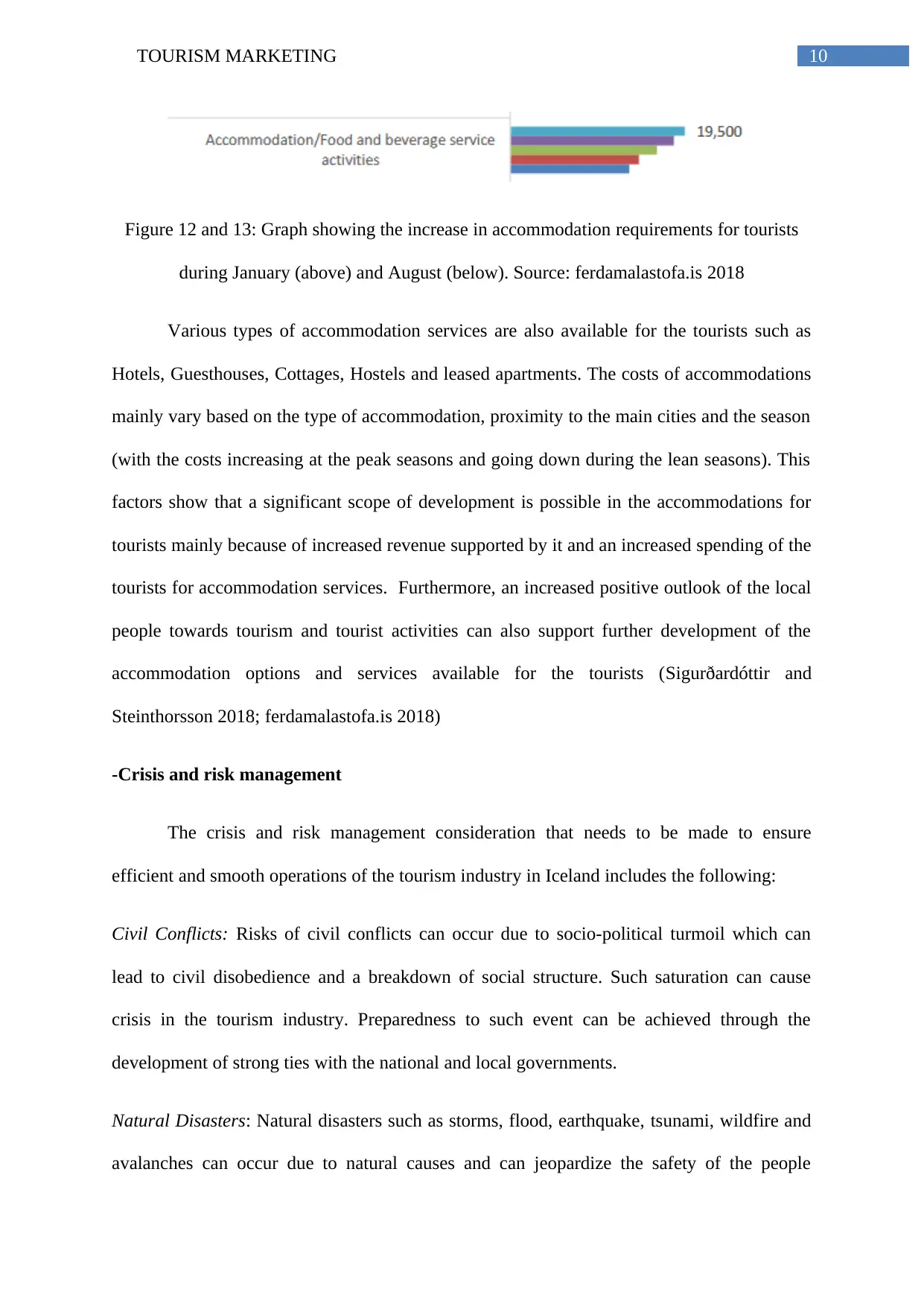
10TOURISM MARKETING
Figure 12 and 13: Graph showing the increase in accommodation requirements for tourists
during January (above) and August (below). Source: ferdamalastofa.is 2018
Various types of accommodation services are also available for the tourists such as
Hotels, Guesthouses, Cottages, Hostels and leased apartments. The costs of accommodations
mainly vary based on the type of accommodation, proximity to the main cities and the season
(with the costs increasing at the peak seasons and going down during the lean seasons). This
factors show that a significant scope of development is possible in the accommodations for
tourists mainly because of increased revenue supported by it and an increased spending of the
tourists for accommodation services. Furthermore, an increased positive outlook of the local
people towards tourism and tourist activities can also support further development of the
accommodation options and services available for the tourists (Sigurðardóttir and
Steinthorsson 2018; ferdamalastofa.is 2018)
-Crisis and risk management
The crisis and risk management consideration that needs to be made to ensure
efficient and smooth operations of the tourism industry in Iceland includes the following:
Civil Conflicts: Risks of civil conflicts can occur due to socio-political turmoil which can
lead to civil disobedience and a breakdown of social structure. Such saturation can cause
crisis in the tourism industry. Preparedness to such event can be achieved through the
development of strong ties with the national and local governments.
Natural Disasters: Natural disasters such as storms, flood, earthquake, tsunami, wildfire and
avalanches can occur due to natural causes and can jeopardize the safety of the people
Figure 12 and 13: Graph showing the increase in accommodation requirements for tourists
during January (above) and August (below). Source: ferdamalastofa.is 2018
Various types of accommodation services are also available for the tourists such as
Hotels, Guesthouses, Cottages, Hostels and leased apartments. The costs of accommodations
mainly vary based on the type of accommodation, proximity to the main cities and the season
(with the costs increasing at the peak seasons and going down during the lean seasons). This
factors show that a significant scope of development is possible in the accommodations for
tourists mainly because of increased revenue supported by it and an increased spending of the
tourists for accommodation services. Furthermore, an increased positive outlook of the local
people towards tourism and tourist activities can also support further development of the
accommodation options and services available for the tourists (Sigurðardóttir and
Steinthorsson 2018; ferdamalastofa.is 2018)
-Crisis and risk management
The crisis and risk management consideration that needs to be made to ensure
efficient and smooth operations of the tourism industry in Iceland includes the following:
Civil Conflicts: Risks of civil conflicts can occur due to socio-political turmoil which can
lead to civil disobedience and a breakdown of social structure. Such saturation can cause
crisis in the tourism industry. Preparedness to such event can be achieved through the
development of strong ties with the national and local governments.
Natural Disasters: Natural disasters such as storms, flood, earthquake, tsunami, wildfire and
avalanches can occur due to natural causes and can jeopardize the safety of the people
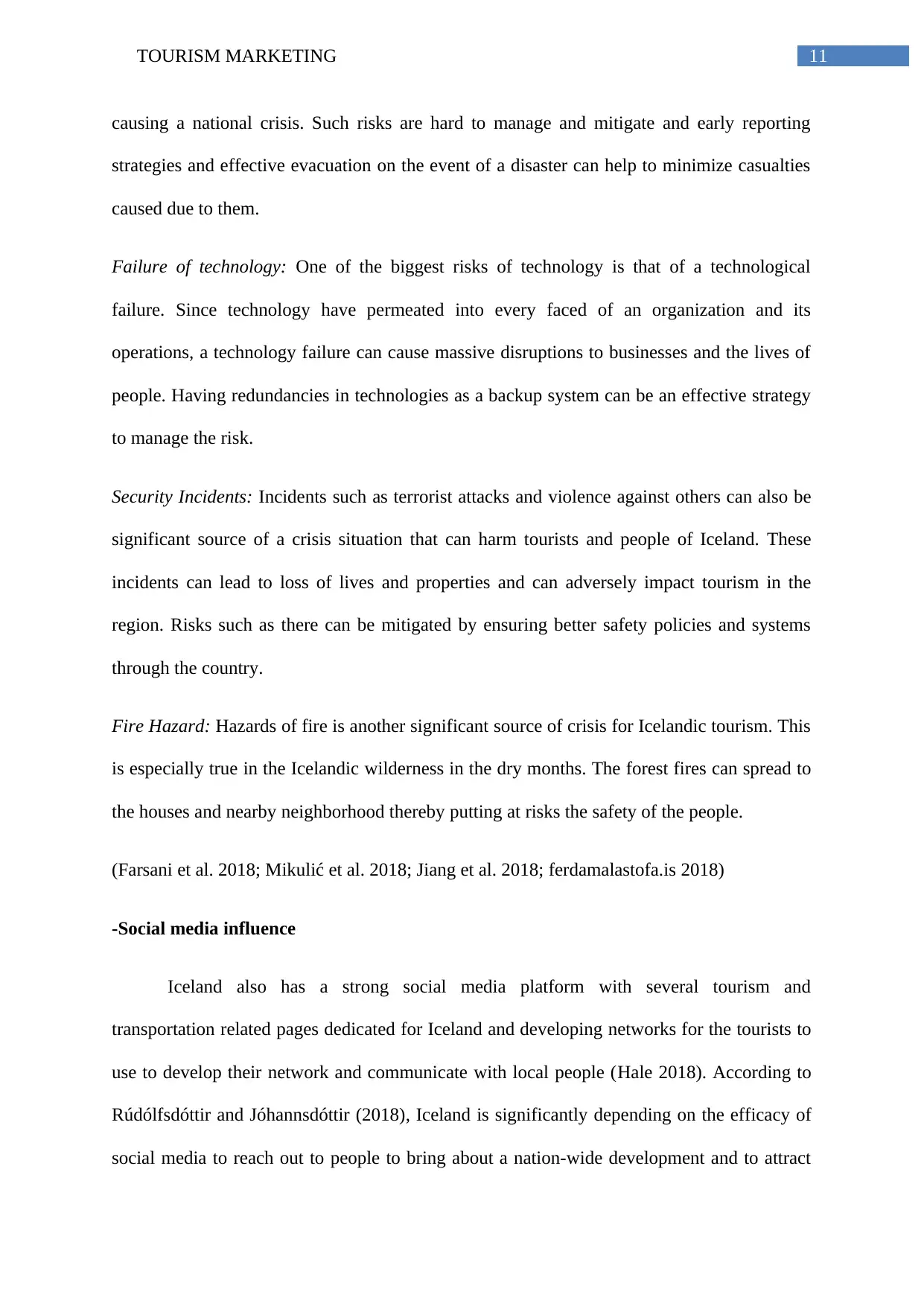
11TOURISM MARKETING
causing a national crisis. Such risks are hard to manage and mitigate and early reporting
strategies and effective evacuation on the event of a disaster can help to minimize casualties
caused due to them.
Failure of technology: One of the biggest risks of technology is that of a technological
failure. Since technology have permeated into every faced of an organization and its
operations, a technology failure can cause massive disruptions to businesses and the lives of
people. Having redundancies in technologies as a backup system can be an effective strategy
to manage the risk.
Security Incidents: Incidents such as terrorist attacks and violence against others can also be
significant source of a crisis situation that can harm tourists and people of Iceland. These
incidents can lead to loss of lives and properties and can adversely impact tourism in the
region. Risks such as there can be mitigated by ensuring better safety policies and systems
through the country.
Fire Hazard: Hazards of fire is another significant source of crisis for Icelandic tourism. This
is especially true in the Icelandic wilderness in the dry months. The forest fires can spread to
the houses and nearby neighborhood thereby putting at risks the safety of the people.
(Farsani et al. 2018; Mikulić et al. 2018; Jiang et al. 2018; ferdamalastofa.is 2018)
-Social media influence
Iceland also has a strong social media platform with several tourism and
transportation related pages dedicated for Iceland and developing networks for the tourists to
use to develop their network and communicate with local people (Hale 2018). According to
Rúdólfsdóttir and Jóhannsdóttir (2018), Iceland is significantly depending on the efficacy of
social media to reach out to people to bring about a nation-wide development and to attract
causing a national crisis. Such risks are hard to manage and mitigate and early reporting
strategies and effective evacuation on the event of a disaster can help to minimize casualties
caused due to them.
Failure of technology: One of the biggest risks of technology is that of a technological
failure. Since technology have permeated into every faced of an organization and its
operations, a technology failure can cause massive disruptions to businesses and the lives of
people. Having redundancies in technologies as a backup system can be an effective strategy
to manage the risk.
Security Incidents: Incidents such as terrorist attacks and violence against others can also be
significant source of a crisis situation that can harm tourists and people of Iceland. These
incidents can lead to loss of lives and properties and can adversely impact tourism in the
region. Risks such as there can be mitigated by ensuring better safety policies and systems
through the country.
Fire Hazard: Hazards of fire is another significant source of crisis for Icelandic tourism. This
is especially true in the Icelandic wilderness in the dry months. The forest fires can spread to
the houses and nearby neighborhood thereby putting at risks the safety of the people.
(Farsani et al. 2018; Mikulić et al. 2018; Jiang et al. 2018; ferdamalastofa.is 2018)
-Social media influence
Iceland also has a strong social media platform with several tourism and
transportation related pages dedicated for Iceland and developing networks for the tourists to
use to develop their network and communicate with local people (Hale 2018). According to
Rúdólfsdóttir and Jóhannsdóttir (2018), Iceland is significantly depending on the efficacy of
social media to reach out to people to bring about a nation-wide development and to attract
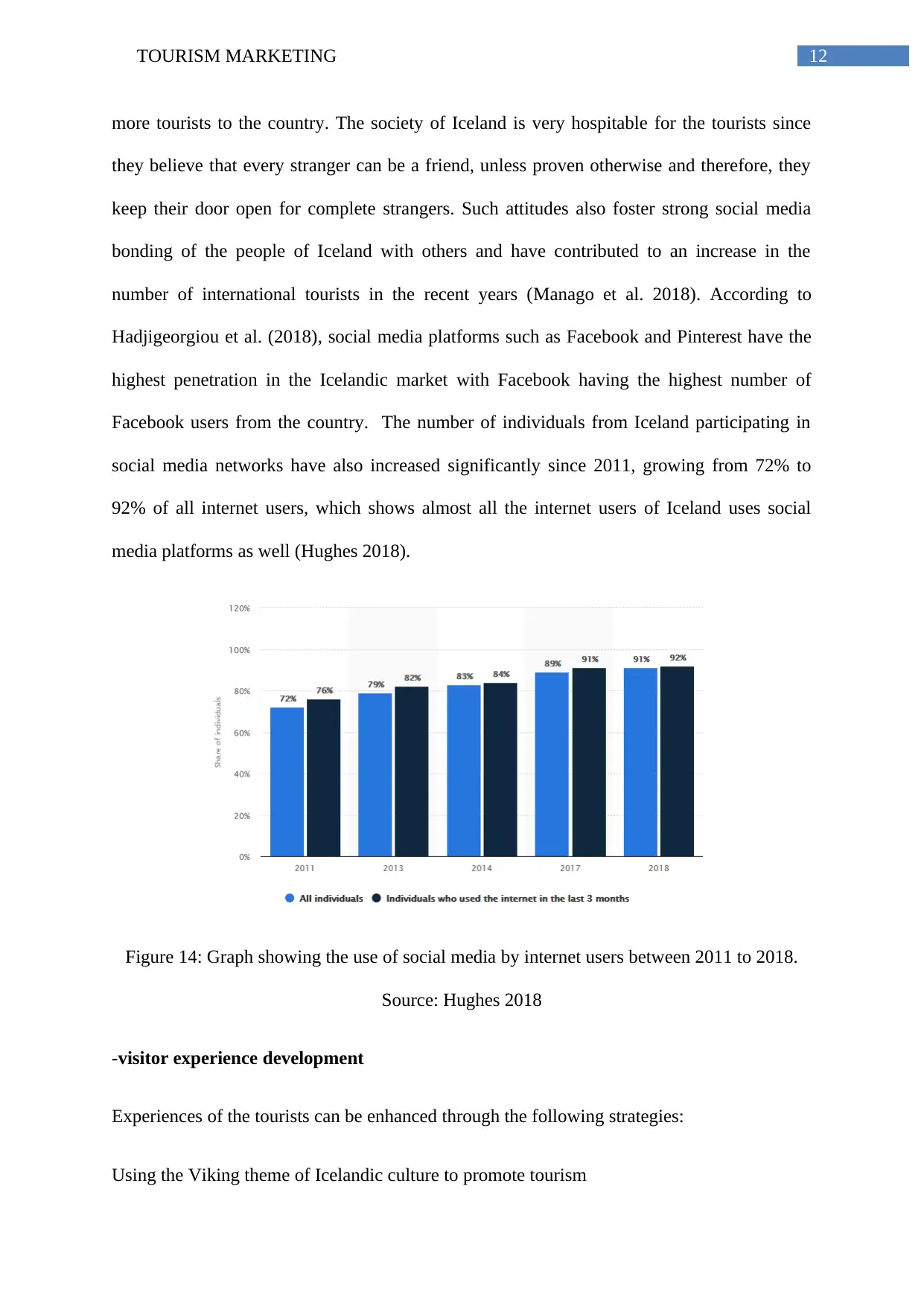
12TOURISM MARKETING
more tourists to the country. The society of Iceland is very hospitable for the tourists since
they believe that every stranger can be a friend, unless proven otherwise and therefore, they
keep their door open for complete strangers. Such attitudes also foster strong social media
bonding of the people of Iceland with others and have contributed to an increase in the
number of international tourists in the recent years (Manago et al. 2018). According to
Hadjigeorgiou et al. (2018), social media platforms such as Facebook and Pinterest have the
highest penetration in the Icelandic market with Facebook having the highest number of
Facebook users from the country. The number of individuals from Iceland participating in
social media networks have also increased significantly since 2011, growing from 72% to
92% of all internet users, which shows almost all the internet users of Iceland uses social
media platforms as well (Hughes 2018).
Figure 14: Graph showing the use of social media by internet users between 2011 to 2018.
Source: Hughes 2018
-visitor experience development
Experiences of the tourists can be enhanced through the following strategies:
Using the Viking theme of Icelandic culture to promote tourism
more tourists to the country. The society of Iceland is very hospitable for the tourists since
they believe that every stranger can be a friend, unless proven otherwise and therefore, they
keep their door open for complete strangers. Such attitudes also foster strong social media
bonding of the people of Iceland with others and have contributed to an increase in the
number of international tourists in the recent years (Manago et al. 2018). According to
Hadjigeorgiou et al. (2018), social media platforms such as Facebook and Pinterest have the
highest penetration in the Icelandic market with Facebook having the highest number of
Facebook users from the country. The number of individuals from Iceland participating in
social media networks have also increased significantly since 2011, growing from 72% to
92% of all internet users, which shows almost all the internet users of Iceland uses social
media platforms as well (Hughes 2018).
Figure 14: Graph showing the use of social media by internet users between 2011 to 2018.
Source: Hughes 2018
-visitor experience development
Experiences of the tourists can be enhanced through the following strategies:
Using the Viking theme of Icelandic culture to promote tourism
Secure Best Marks with AI Grader
Need help grading? Try our AI Grader for instant feedback on your assignments.

13TOURISM MARKETING
Develop complete interconnectedness of tourist places for easy accessibility: This can allow
the tourists to easily travel from one destination to next within the country and therefore save
time by avoiding the time to await booking confirmations and on long waiting lines.
Using knowledgeable tour guides to provide information about various places and their
histories: Knowledgeable tour guides can enhance the experience by providing authentic
information to the tourists about various places and their cultural and historic importance.
Using personal mobile apps to guide the tourists: Mobile apps can be developed that can be
used by tourists to find nearest places to see, stay or avail food and things they can do to
enjoy their stay in Iceland. This can also provide the tourists more freedom of movement and
monitor their location in real-time.
Developing emergency help services for the tourists: Emergency help services can provide an
emergency point of contact for the tourists in case they require any assistance in their travel.
This can also enhance their sense of safety and security and help them to have a better
experience of the travel by immersing in the experience in a more holistic manner.
Souvenirs: The tourists can purchase mementos and souvenirs from the country that can
remind them of the culture, natural beauty and friendliness of the people and therefore help to
enhance their experience of the place.
Effective design of the company website: The Company’s website can also be effectively
designed, highlighting the beauty and culture of the place to attract more customers though
better experience of the site.
Providing a local and off the beaten path experience: One of the best strategies to enhance
the experience of the travelers is to include an authentic, of the beaten path and localized
Develop complete interconnectedness of tourist places for easy accessibility: This can allow
the tourists to easily travel from one destination to next within the country and therefore save
time by avoiding the time to await booking confirmations and on long waiting lines.
Using knowledgeable tour guides to provide information about various places and their
histories: Knowledgeable tour guides can enhance the experience by providing authentic
information to the tourists about various places and their cultural and historic importance.
Using personal mobile apps to guide the tourists: Mobile apps can be developed that can be
used by tourists to find nearest places to see, stay or avail food and things they can do to
enjoy their stay in Iceland. This can also provide the tourists more freedom of movement and
monitor their location in real-time.
Developing emergency help services for the tourists: Emergency help services can provide an
emergency point of contact for the tourists in case they require any assistance in their travel.
This can also enhance their sense of safety and security and help them to have a better
experience of the travel by immersing in the experience in a more holistic manner.
Souvenirs: The tourists can purchase mementos and souvenirs from the country that can
remind them of the culture, natural beauty and friendliness of the people and therefore help to
enhance their experience of the place.
Effective design of the company website: The Company’s website can also be effectively
designed, highlighting the beauty and culture of the place to attract more customers though
better experience of the site.
Providing a local and off the beaten path experience: One of the best strategies to enhance
the experience of the travelers is to include an authentic, of the beaten path and localized
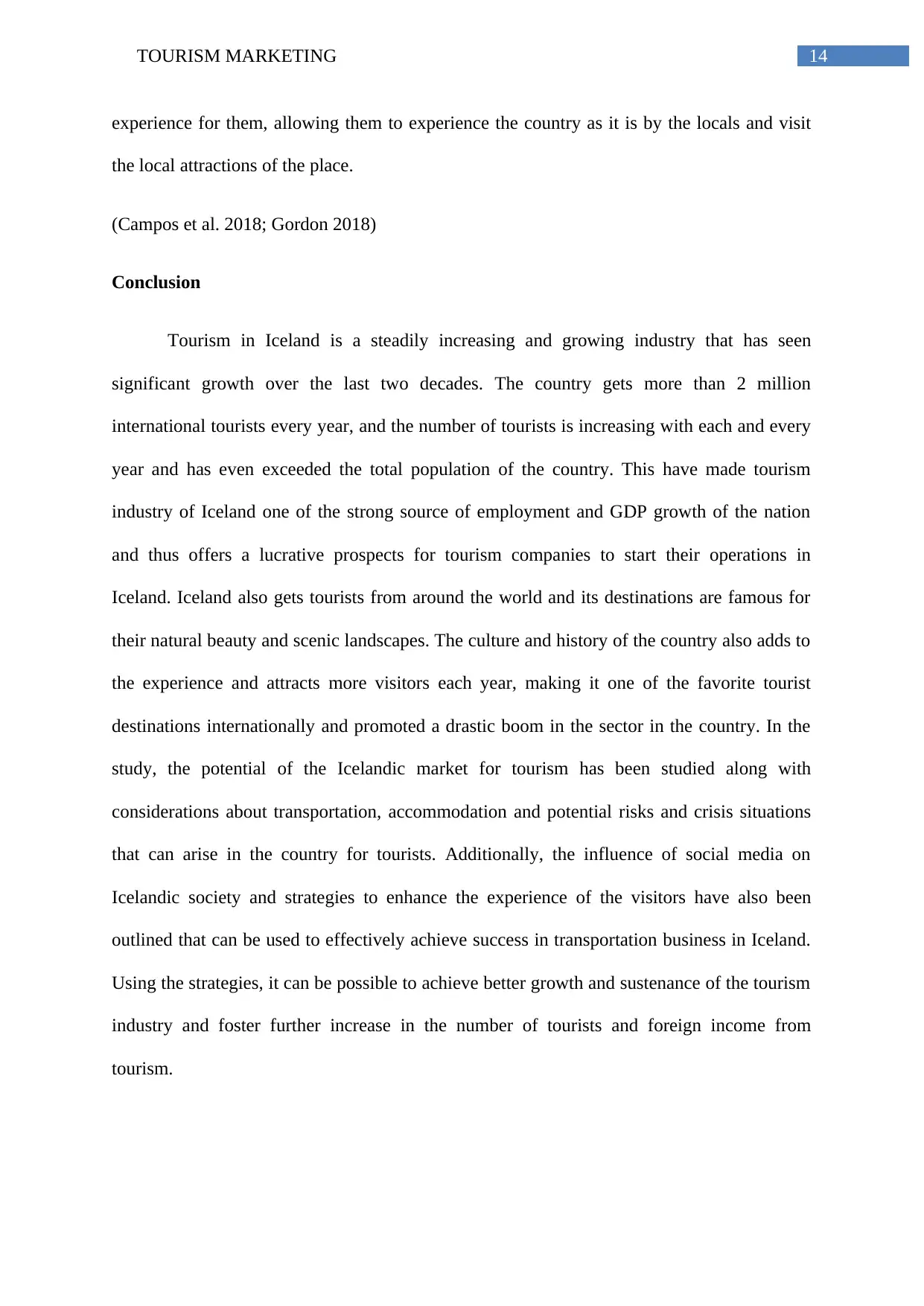
14TOURISM MARKETING
experience for them, allowing them to experience the country as it is by the locals and visit
the local attractions of the place.
(Campos et al. 2018; Gordon 2018)
Conclusion
Tourism in Iceland is a steadily increasing and growing industry that has seen
significant growth over the last two decades. The country gets more than 2 million
international tourists every year, and the number of tourists is increasing with each and every
year and has even exceeded the total population of the country. This have made tourism
industry of Iceland one of the strong source of employment and GDP growth of the nation
and thus offers a lucrative prospects for tourism companies to start their operations in
Iceland. Iceland also gets tourists from around the world and its destinations are famous for
their natural beauty and scenic landscapes. The culture and history of the country also adds to
the experience and attracts more visitors each year, making it one of the favorite tourist
destinations internationally and promoted a drastic boom in the sector in the country. In the
study, the potential of the Icelandic market for tourism has been studied along with
considerations about transportation, accommodation and potential risks and crisis situations
that can arise in the country for tourists. Additionally, the influence of social media on
Icelandic society and strategies to enhance the experience of the visitors have also been
outlined that can be used to effectively achieve success in transportation business in Iceland.
Using the strategies, it can be possible to achieve better growth and sustenance of the tourism
industry and foster further increase in the number of tourists and foreign income from
tourism.
experience for them, allowing them to experience the country as it is by the locals and visit
the local attractions of the place.
(Campos et al. 2018; Gordon 2018)
Conclusion
Tourism in Iceland is a steadily increasing and growing industry that has seen
significant growth over the last two decades. The country gets more than 2 million
international tourists every year, and the number of tourists is increasing with each and every
year and has even exceeded the total population of the country. This have made tourism
industry of Iceland one of the strong source of employment and GDP growth of the nation
and thus offers a lucrative prospects for tourism companies to start their operations in
Iceland. Iceland also gets tourists from around the world and its destinations are famous for
their natural beauty and scenic landscapes. The culture and history of the country also adds to
the experience and attracts more visitors each year, making it one of the favorite tourist
destinations internationally and promoted a drastic boom in the sector in the country. In the
study, the potential of the Icelandic market for tourism has been studied along with
considerations about transportation, accommodation and potential risks and crisis situations
that can arise in the country for tourists. Additionally, the influence of social media on
Icelandic society and strategies to enhance the experience of the visitors have also been
outlined that can be used to effectively achieve success in transportation business in Iceland.
Using the strategies, it can be possible to achieve better growth and sustenance of the tourism
industry and foster further increase in the number of tourists and foreign income from
tourism.
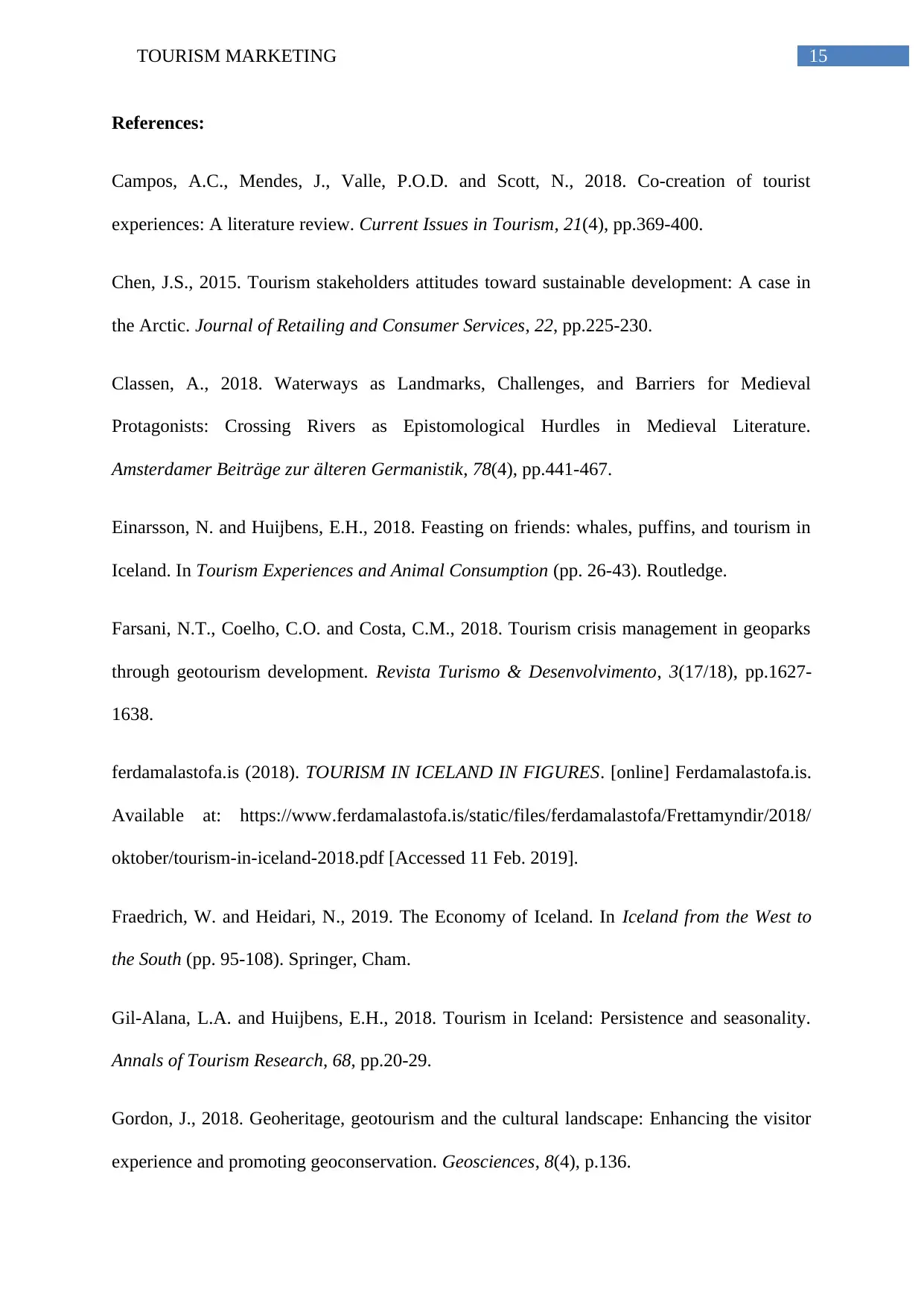
15TOURISM MARKETING
References:
Campos, A.C., Mendes, J., Valle, P.O.D. and Scott, N., 2018. Co-creation of tourist
experiences: A literature review. Current Issues in Tourism, 21(4), pp.369-400.
Chen, J.S., 2015. Tourism stakeholders attitudes toward sustainable development: A case in
the Arctic. Journal of Retailing and Consumer Services, 22, pp.225-230.
Classen, A., 2018. Waterways as Landmarks, Challenges, and Barriers for Medieval
Protagonists: Crossing Rivers as Epistomological Hurdles in Medieval Literature.
Amsterdamer Beiträge zur älteren Germanistik, 78(4), pp.441-467.
Einarsson, N. and Huijbens, E.H., 2018. Feasting on friends: whales, puffins, and tourism in
Iceland. In Tourism Experiences and Animal Consumption (pp. 26-43). Routledge.
Farsani, N.T., Coelho, C.O. and Costa, C.M., 2018. Tourism crisis management in geoparks
through geotourism development. Revista Turismo & Desenvolvimento, 3(17/18), pp.1627-
1638.
ferdamalastofa.is (2018). TOURISM IN ICELAND IN FIGURES. [online] Ferdamalastofa.is.
Available at: https://www.ferdamalastofa.is/static/files/ferdamalastofa/Frettamyndir/2018/
oktober/tourism-in-iceland-2018.pdf [Accessed 11 Feb. 2019].
Fraedrich, W. and Heidari, N., 2019. The Economy of Iceland. In Iceland from the West to
the South (pp. 95-108). Springer, Cham.
Gil-Alana, L.A. and Huijbens, E.H., 2018. Tourism in Iceland: Persistence and seasonality.
Annals of Tourism Research, 68, pp.20-29.
Gordon, J., 2018. Geoheritage, geotourism and the cultural landscape: Enhancing the visitor
experience and promoting geoconservation. Geosciences, 8(4), p.136.
References:
Campos, A.C., Mendes, J., Valle, P.O.D. and Scott, N., 2018. Co-creation of tourist
experiences: A literature review. Current Issues in Tourism, 21(4), pp.369-400.
Chen, J.S., 2015. Tourism stakeholders attitudes toward sustainable development: A case in
the Arctic. Journal of Retailing and Consumer Services, 22, pp.225-230.
Classen, A., 2018. Waterways as Landmarks, Challenges, and Barriers for Medieval
Protagonists: Crossing Rivers as Epistomological Hurdles in Medieval Literature.
Amsterdamer Beiträge zur älteren Germanistik, 78(4), pp.441-467.
Einarsson, N. and Huijbens, E.H., 2018. Feasting on friends: whales, puffins, and tourism in
Iceland. In Tourism Experiences and Animal Consumption (pp. 26-43). Routledge.
Farsani, N.T., Coelho, C.O. and Costa, C.M., 2018. Tourism crisis management in geoparks
through geotourism development. Revista Turismo & Desenvolvimento, 3(17/18), pp.1627-
1638.
ferdamalastofa.is (2018). TOURISM IN ICELAND IN FIGURES. [online] Ferdamalastofa.is.
Available at: https://www.ferdamalastofa.is/static/files/ferdamalastofa/Frettamyndir/2018/
oktober/tourism-in-iceland-2018.pdf [Accessed 11 Feb. 2019].
Fraedrich, W. and Heidari, N., 2019. The Economy of Iceland. In Iceland from the West to
the South (pp. 95-108). Springer, Cham.
Gil-Alana, L.A. and Huijbens, E.H., 2018. Tourism in Iceland: Persistence and seasonality.
Annals of Tourism Research, 68, pp.20-29.
Gordon, J., 2018. Geoheritage, geotourism and the cultural landscape: Enhancing the visitor
experience and promoting geoconservation. Geosciences, 8(4), p.136.
Paraphrase This Document
Need a fresh take? Get an instant paraphrase of this document with our AI Paraphraser
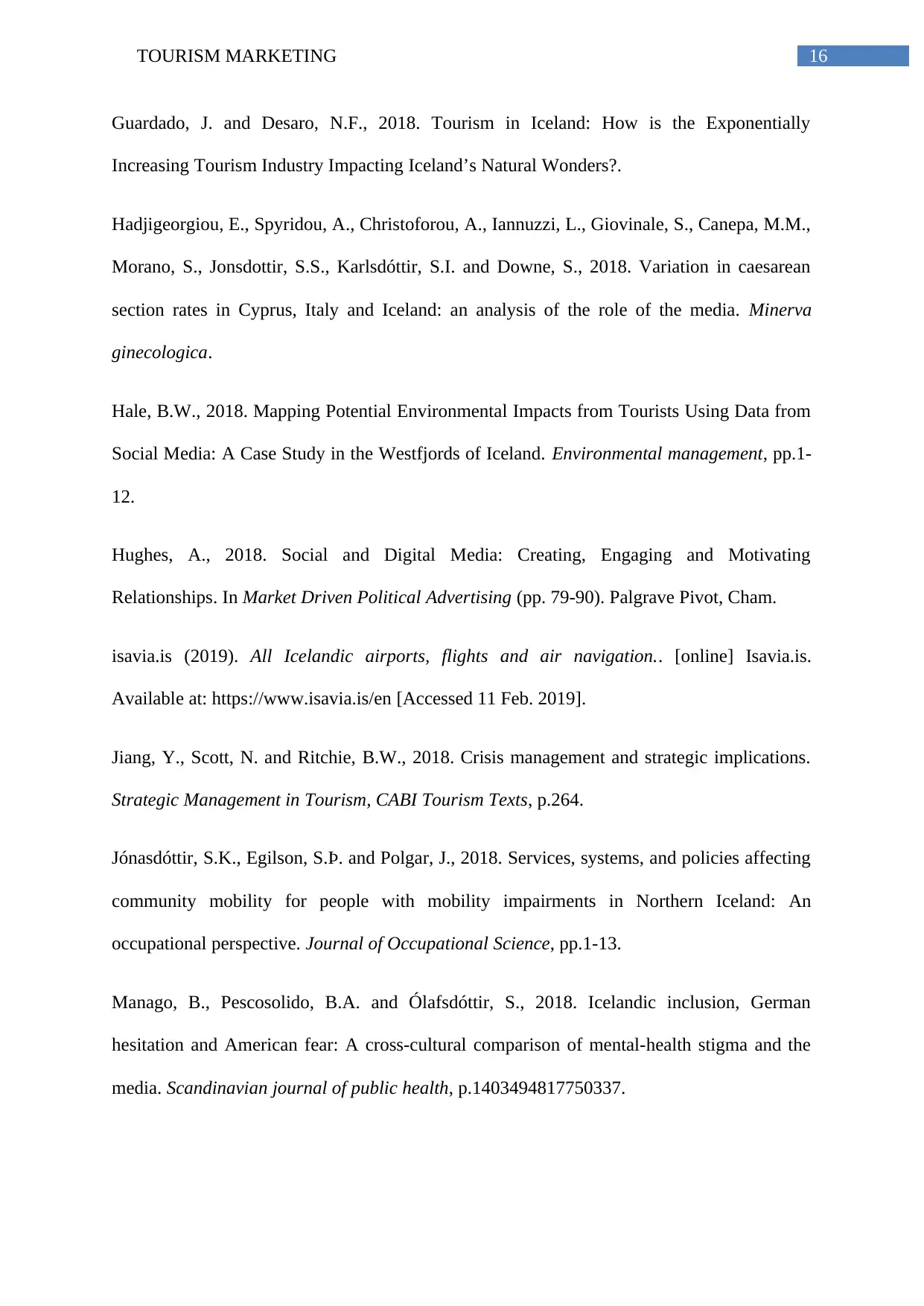
16TOURISM MARKETING
Guardado, J. and Desaro, N.F., 2018. Tourism in Iceland: How is the Exponentially
Increasing Tourism Industry Impacting Iceland’s Natural Wonders?.
Hadjigeorgiou, E., Spyridou, A., Christoforou, A., Iannuzzi, L., Giovinale, S., Canepa, M.M.,
Morano, S., Jonsdottir, S.S., Karlsdóttir, S.I. and Downe, S., 2018. Variation in caesarean
section rates in Cyprus, Italy and Iceland: an analysis of the role of the media. Minerva
ginecologica.
Hale, B.W., 2018. Mapping Potential Environmental Impacts from Tourists Using Data from
Social Media: A Case Study in the Westfjords of Iceland. Environmental management, pp.1-
12.
Hughes, A., 2018. Social and Digital Media: Creating, Engaging and Motivating
Relationships. In Market Driven Political Advertising (pp. 79-90). Palgrave Pivot, Cham.
isavia.is (2019). All Icelandic airports, flights and air navigation.. [online] Isavia.is.
Available at: https://www.isavia.is/en [Accessed 11 Feb. 2019].
Jiang, Y., Scott, N. and Ritchie, B.W., 2018. Crisis management and strategic implications.
Strategic Management in Tourism, CABI Tourism Texts, p.264.
Jónasdóttir, S.K., Egilson, S.Þ. and Polgar, J., 2018. Services, systems, and policies affecting
community mobility for people with mobility impairments in Northern Iceland: An
occupational perspective. Journal of Occupational Science, pp.1-13.
Manago, B., Pescosolido, B.A. and Ólafsdóttir, S., 2018. Icelandic inclusion, German
hesitation and American fear: A cross-cultural comparison of mental-health stigma and the
media. Scandinavian journal of public health, p.1403494817750337.
Guardado, J. and Desaro, N.F., 2018. Tourism in Iceland: How is the Exponentially
Increasing Tourism Industry Impacting Iceland’s Natural Wonders?.
Hadjigeorgiou, E., Spyridou, A., Christoforou, A., Iannuzzi, L., Giovinale, S., Canepa, M.M.,
Morano, S., Jonsdottir, S.S., Karlsdóttir, S.I. and Downe, S., 2018. Variation in caesarean
section rates in Cyprus, Italy and Iceland: an analysis of the role of the media. Minerva
ginecologica.
Hale, B.W., 2018. Mapping Potential Environmental Impacts from Tourists Using Data from
Social Media: A Case Study in the Westfjords of Iceland. Environmental management, pp.1-
12.
Hughes, A., 2018. Social and Digital Media: Creating, Engaging and Motivating
Relationships. In Market Driven Political Advertising (pp. 79-90). Palgrave Pivot, Cham.
isavia.is (2019). All Icelandic airports, flights and air navigation.. [online] Isavia.is.
Available at: https://www.isavia.is/en [Accessed 11 Feb. 2019].
Jiang, Y., Scott, N. and Ritchie, B.W., 2018. Crisis management and strategic implications.
Strategic Management in Tourism, CABI Tourism Texts, p.264.
Jónasdóttir, S.K., Egilson, S.Þ. and Polgar, J., 2018. Services, systems, and policies affecting
community mobility for people with mobility impairments in Northern Iceland: An
occupational perspective. Journal of Occupational Science, pp.1-13.
Manago, B., Pescosolido, B.A. and Ólafsdóttir, S., 2018. Icelandic inclusion, German
hesitation and American fear: A cross-cultural comparison of mental-health stigma and the
media. Scandinavian journal of public health, p.1403494817750337.
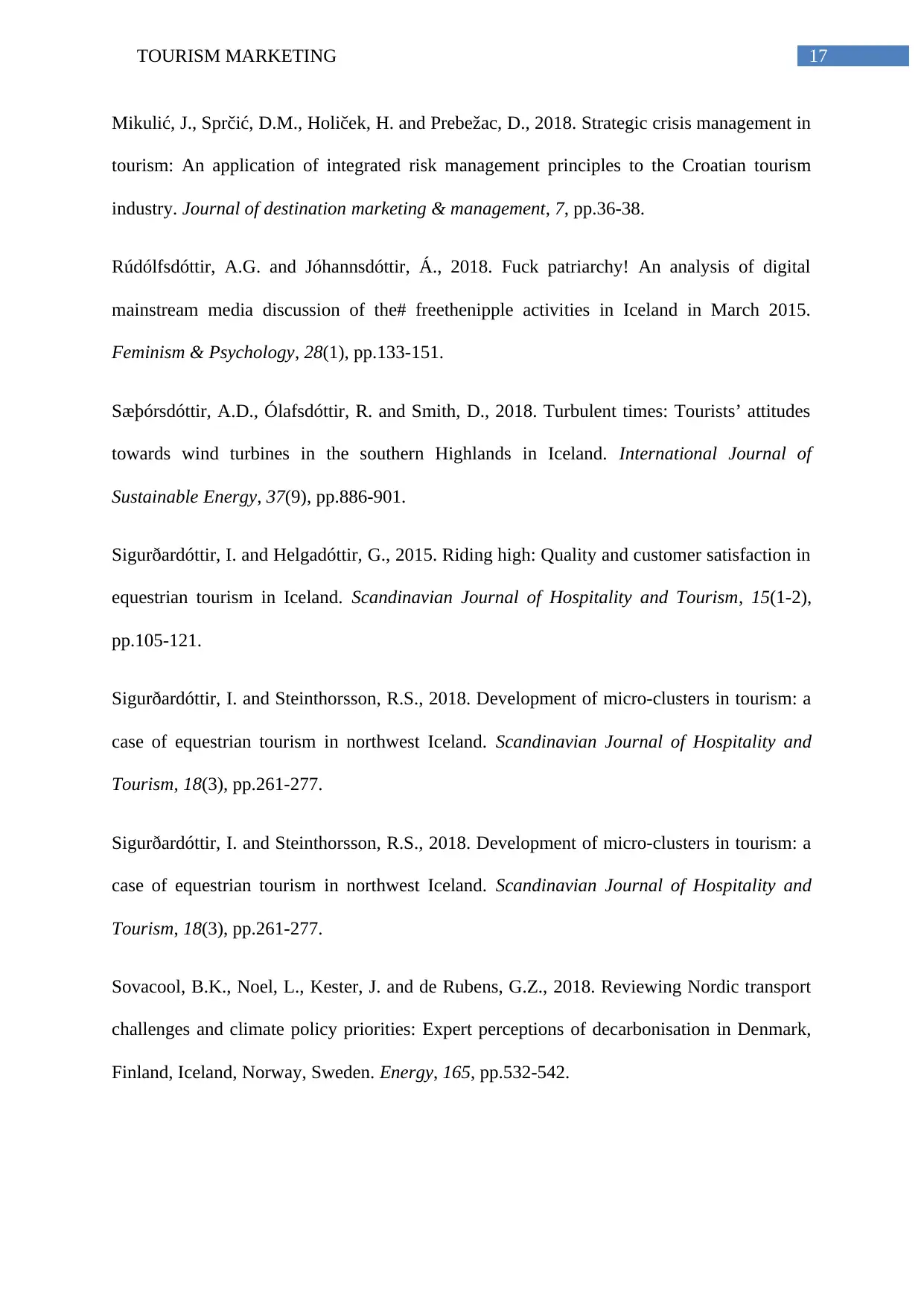
17TOURISM MARKETING
Mikulić, J., Sprčić, D.M., Holiček, H. and Prebežac, D., 2018. Strategic crisis management in
tourism: An application of integrated risk management principles to the Croatian tourism
industry. Journal of destination marketing & management, 7, pp.36-38.
Rúdólfsdóttir, A.G. and Jóhannsdóttir, Á., 2018. Fuck patriarchy! An analysis of digital
mainstream media discussion of the# freethenipple activities in Iceland in March 2015.
Feminism & Psychology, 28(1), pp.133-151.
Sæþórsdóttir, A.D., Ólafsdóttir, R. and Smith, D., 2018. Turbulent times: Tourists’ attitudes
towards wind turbines in the southern Highlands in Iceland. International Journal of
Sustainable Energy, 37(9), pp.886-901.
Sigurðardóttir, I. and Helgadóttir, G., 2015. Riding high: Quality and customer satisfaction in
equestrian tourism in Iceland. Scandinavian Journal of Hospitality and Tourism, 15(1-2),
pp.105-121.
Sigurðardóttir, I. and Steinthorsson, R.S., 2018. Development of micro-clusters in tourism: a
case of equestrian tourism in northwest Iceland. Scandinavian Journal of Hospitality and
Tourism, 18(3), pp.261-277.
Sigurðardóttir, I. and Steinthorsson, R.S., 2018. Development of micro-clusters in tourism: a
case of equestrian tourism in northwest Iceland. Scandinavian Journal of Hospitality and
Tourism, 18(3), pp.261-277.
Sovacool, B.K., Noel, L., Kester, J. and de Rubens, G.Z., 2018. Reviewing Nordic transport
challenges and climate policy priorities: Expert perceptions of decarbonisation in Denmark,
Finland, Iceland, Norway, Sweden. Energy, 165, pp.532-542.
Mikulić, J., Sprčić, D.M., Holiček, H. and Prebežac, D., 2018. Strategic crisis management in
tourism: An application of integrated risk management principles to the Croatian tourism
industry. Journal of destination marketing & management, 7, pp.36-38.
Rúdólfsdóttir, A.G. and Jóhannsdóttir, Á., 2018. Fuck patriarchy! An analysis of digital
mainstream media discussion of the# freethenipple activities in Iceland in March 2015.
Feminism & Psychology, 28(1), pp.133-151.
Sæþórsdóttir, A.D., Ólafsdóttir, R. and Smith, D., 2018. Turbulent times: Tourists’ attitudes
towards wind turbines in the southern Highlands in Iceland. International Journal of
Sustainable Energy, 37(9), pp.886-901.
Sigurðardóttir, I. and Helgadóttir, G., 2015. Riding high: Quality and customer satisfaction in
equestrian tourism in Iceland. Scandinavian Journal of Hospitality and Tourism, 15(1-2),
pp.105-121.
Sigurðardóttir, I. and Steinthorsson, R.S., 2018. Development of micro-clusters in tourism: a
case of equestrian tourism in northwest Iceland. Scandinavian Journal of Hospitality and
Tourism, 18(3), pp.261-277.
Sigurðardóttir, I. and Steinthorsson, R.S., 2018. Development of micro-clusters in tourism: a
case of equestrian tourism in northwest Iceland. Scandinavian Journal of Hospitality and
Tourism, 18(3), pp.261-277.
Sovacool, B.K., Noel, L., Kester, J. and de Rubens, G.Z., 2018. Reviewing Nordic transport
challenges and climate policy priorities: Expert perceptions of decarbonisation in Denmark,
Finland, Iceland, Norway, Sweden. Energy, 165, pp.532-542.
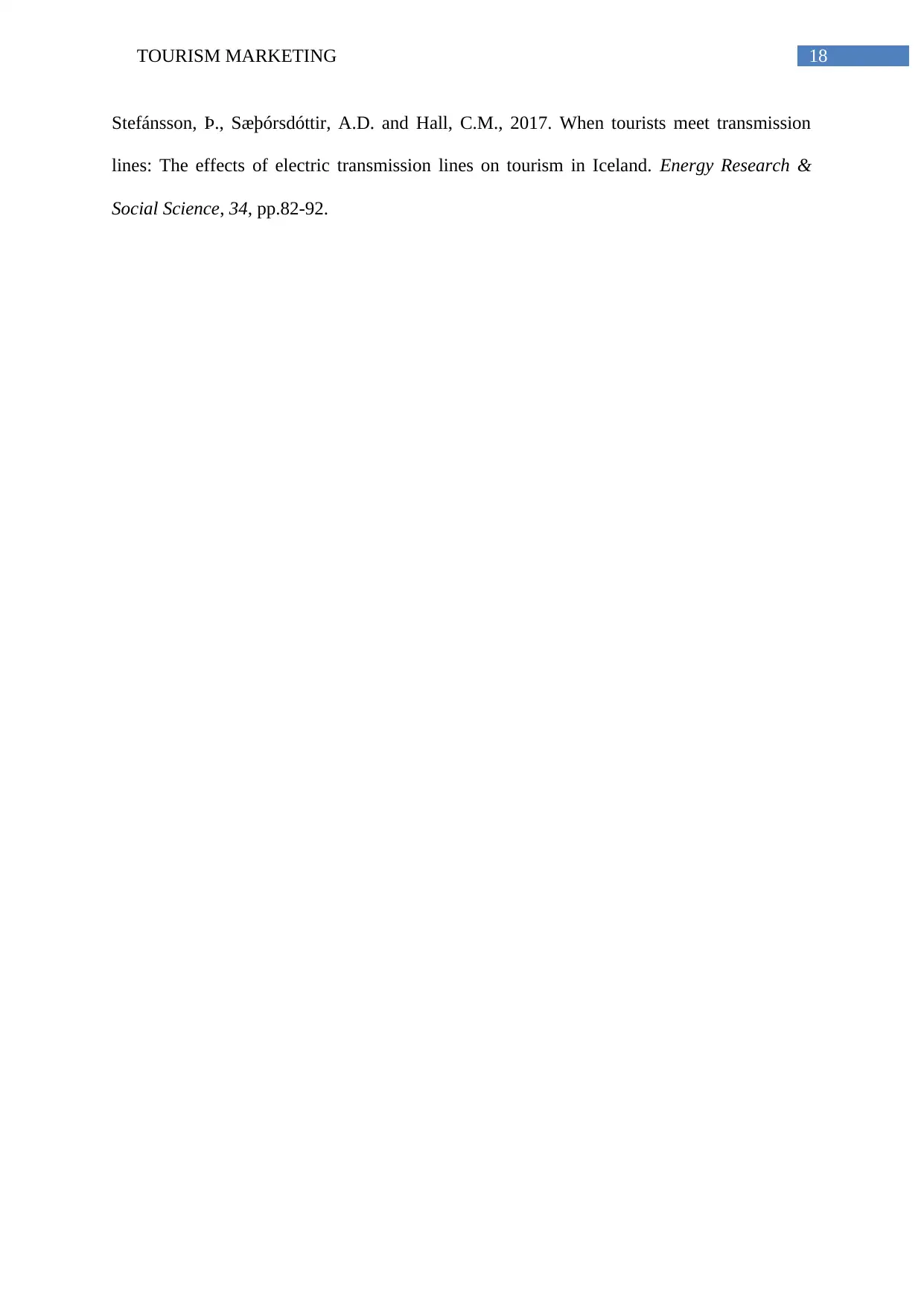
18TOURISM MARKETING
Stefánsson, Þ., Sæþórsdóttir, A.D. and Hall, C.M., 2017. When tourists meet transmission
lines: The effects of electric transmission lines on tourism in Iceland. Energy Research &
Social Science, 34, pp.82-92.
Stefánsson, Þ., Sæþórsdóttir, A.D. and Hall, C.M., 2017. When tourists meet transmission
lines: The effects of electric transmission lines on tourism in Iceland. Energy Research &
Social Science, 34, pp.82-92.
1 out of 19
Related Documents
Your All-in-One AI-Powered Toolkit for Academic Success.
+13062052269
info@desklib.com
Available 24*7 on WhatsApp / Email
![[object Object]](/_next/static/media/star-bottom.7253800d.svg)
Unlock your academic potential
© 2024 | Zucol Services PVT LTD | All rights reserved.





